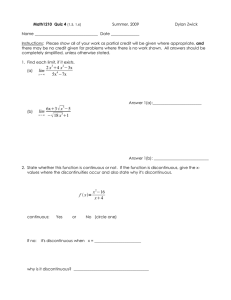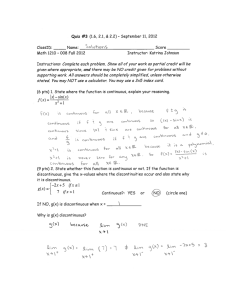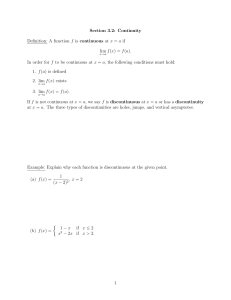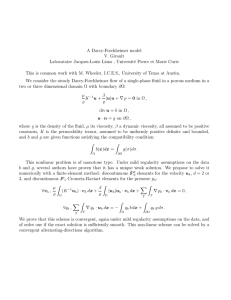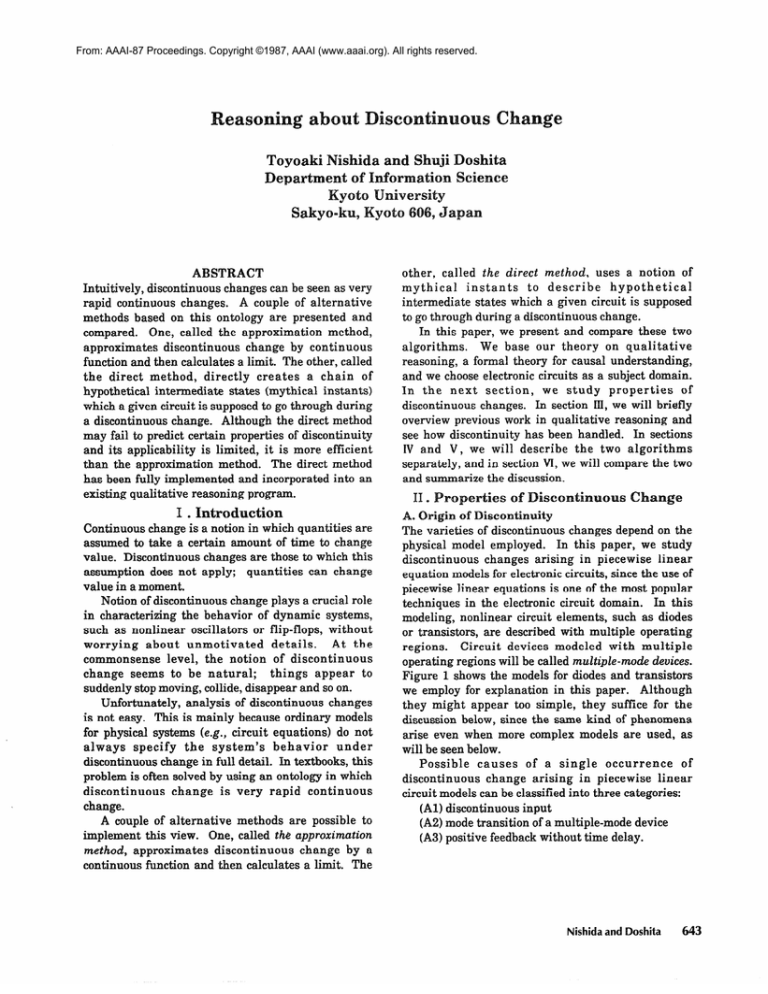
From: AAAI-87 Proceedings. Copyright ©1987, AAAI (www.aaai.org). All rights reserved.
s
Toyoaki Nishida and Shuji
of Pnformation Science
Departs
oto university
an
ABSTRACT
Intuitively, discontinuous changes can be seen as very
rapid continuous changes.
A couple of alternative
methods based on this ontology are presented and
compared.
One, called the approximation
method,
approximates
discontinuous
change by continuous
function and then calculates a limit. The other, called
the direct method,
directly
creates
a chain
of
hypothetical intermediate states (mythical instants)
which a given circuit is supposed to go through during
a discontinuous change. Although the direct method
may fail to predict certain properties of discontinuity
and its applicability
is limited, it is more efficient
than the approximation method. The direct method
has been fully implemented and incorporated into an
existing qualitative reasoning program.
other, called the direct
method,
uses a notion of
mythical
instants
to describe
hypothetical
intermediate states which a given circuit is supposed
to go through during a discontinuous change.
In this paper, we present and compare these two
algorithms.
We base our theory on qualitative
reasoning, a formal theory for causal understanding,
and we choose electronic circuits as a subject domain.
we study
properties
of
In the next section,
discontinuous changes. In section ill, we will briefly
overview previous work in qualitative reasoning and
see how discontinuity has been handled. In sections
IV and V, we will describe
the two algorithms
separately, and in section Vl, we will compare the two
and summarize the discussion.
I . Introdmctisn
Continuous change is a notion in which quantities are
assumed to take a certain amount of time to change
value. Discontinuous changes are those to which this
assumption does not apply;
quantities can change
value in a moment.
Notion of discontinuous change plays a crucial role
in characterizing the behavior of dynamic systems,
such as nonlinear oscillators or flip-flops, without
At the
worrying
about unmotivated
details.
commonsense
level, the notion of discontinuous
things appear to
change seems to be natural;
suddenly stop moving, collide, disappear and so on.
Unfortunately, analysis of discontinuous changes
is not easy. This is mainly because ordinary models
for physical systems (e.g., circuit equations) do not
always
specify
the system’s
behavior
under
discontinuous change in full detail. In textbooks, this
problem is often solved by using an ontology in which
discontinuous
change
is very rapid continuous
change.
A couple of alternative
methods are possible to
implement this view. One, called the approximation
method, approximates
discontinuous
change by a
continuous function and then calculates a limit. The
The varieties of discontinuous changes depend on the
physical model employed.
In this paper, we study
discontinuous
changes arising in piecewise
linear
equation models for electronic circuits, since the use of
piecewise linear equations is one of the most popular
techniques in the electronic circuit domain.
In this
modeling, nonlinear circuit elements, such as diodes
or transistors, are described with multiple operating
regions.
Circuit devices modeled with multiple
devices.
operating regions will be called multiple-mode
Figure 1 shows the models for diodes and transistors
we employ for explanation in this paper. Although
they might appear too simple, they suffice for the
discussion below, since the same kind of phenomena
arise even when more complex models are used, as
will be seen below.
Possible
causes
of a single
occurrence
of
discontinuous
change arising in piecewise
linear
circuit models can be classified into three categories:
(Al) discontinuous input
(A2) mode transition of a multiple-mode device
(A3) positive feedback without time delay.
Nishida and Doshita
643
(a) A model for diodes.
(b) A model for transistors.
WCd ic
iB-b g&E
......*
‘43E
[OFFi
[ONI
VD <V,,
iD=o.
uD=&, , i&o
L
VBE
CON1
VBE= V,, VCE= 0,
ig2 0, i& 0.
iB+iC=iE,
<Vg,
iE
[OFF]
iB = iC = iE =o.
VBE=~BC+~CE
(uOis a positive constant.)
Figure 1. Device models in piecewise
linear equations.
Discontinuous change caused by cause category Ai
will be referred to as type Ai discontinuity.
Properties of type Al discontinuity
have been
studied in depth in the field of transient analysis.
Mathematical techniques such as Laplace or Fourier
transform
methods
are studied
to see how
discontinuous input affects a given circuit. However,
humans seem to use much simpler method when they
characterize the behavior of many pulse circuits at a
commonsense level.
Type A2 discontinuity
results from the use of
piecewise linear equations as a circuit model.
For
example, the diode model shown in figure l(a) causes
derivatives
of current
or voltage
to change
discontinuously
when the operating region of the
diode transitions. If detailed, nonlinear description of
a circuit device is used, discontinuity
of this type
However, abstract, less precise
might disappear.
models are more useful in characterizing the behavior
of nonlinear devices in such circuits as regulators,
TI’L, or Schmitt triggers. Note also that as long as we
use a piecewise
linear model, we cannot avoid
discontinuous
change
(at least of first order
derivatives) on mode transition.
Positive
feedback
without
time delay may
accelerate
any small disturbance
ad infinitum,
resulting in type A3 discontinuity.
Positive feedback
is not rare in electronic circuits; positive feedback is
observed in circuits containing devices such as tunnel
diodes which exhibit negative incremental resistance
in some operating mode, or one can design a circuit
with positive feedback to create a memory (or a stable
state), to generate pulses, and so on. In fact, the latter
is an important technique in digital circuit design.
Note that a positive feedback will not result in value
jump, if the feedback factor is less than I. Note also
that ordinary qualitative reasoners may produce an
undesired result unless positive feedback is correctly
recognized and handled.
B. Properties of Discontinuous Change
Discontinuous change arising from piecewise
models has at least two properties.
644
Engineering Problem Solving
linear
of the system may
(Property 1) Causal structure
change during
discontinuous
change.
Theories of
qualitative
reasoning
view causality
as a value
dependency among variables.
More computationally,
it can be seen as information flow from the cause to
the effect [de Kleer and Brown, 19841. When a circuit
consists only of passive elements, such as resistors or
capacitors, its causal structure will not change in
general. In contrast, when multiple-mode devices are
involved, the causal structure of a circuit may change
drastically, due to the transition of operating mode.
An analysis program should be able to recognize and
keep track of the change of causal structure so as to
generate a causal explanation.
(Property 2) A number of discontinuous
changes of
different
types
may occur
one after
another.
Discontinuous change applied to the input of a given
circuit will be propagated into other parts, possibly
creating a complex chain of events. The problem here
is that ordinary circuit equations
do not contain
sufficient
information
to explain this process in
stepwise, causal terms.
Consider the hypothetical
circuit shown in figure 2. In textbooks of electronic
vcc
Figure 2. A hypothetical
transistor
circuit.
engineering, the behavior of this circuit with UINbeing
raised from zero is usually explained as follows:
when unvrises and reaches some level, TRI will turn ON,
causing TR2 to turn OFF, causing TR3 to turn ON.
This explanation
states:
implicitly
assumes
state-l:
TRl: OFF, TR2: ON, TR3: OFF
state-2
TRl: ON, TR2: ON, TR3: OFF
the following
state-J: TR1: ON, TR2: OFF, TR3: OFF
state-4: TRl: ON, TR2: OFF, TR3: ON.
Among these, state-2 and state-3 are mythical
in the
sense that they do not satisfy circuit
equations
employed here.
By definition,
mythical
instants
terminate instantaneously.
Although one might want
to use only legal states (namely, state-l and state-c?), a
resulting explanation would be acausal and magical.
This kind of situation arises as long as one uses an
abstract model to capture the physical world.
The
direct method attempts to use mythical
states to
create a causal explanation.
III. Previous Work
So far, the mainstream of qualitative reasoning has
been analysis under continuity assumption [de Kleer,
19841 [Kuipers, I.9841 Williams,
19841. Analysis of
discontinuous
change has received an inadequate
treatment. In the domain of electronic circuits, J. de
Kleer and B. Williams each have given algorithms for
analyzing operating mode transition.
De Kleer’s
EQUAL does not allow discontinuous
change even
when a mode transition occurs [de Kleer, 1984, p.
2’721. Williams
allows discontinuous
change only
when discontinuity is explicitly indicated in a device
model. But neither of the two deals with type Al or
A3 discontinuity or property (2).
Qualitative Process (QP) theory [Forbus, 19841 has
more flexibility
with discontinuous
changes.
Discontinuous change is allowed when processes are
switched or when a special process, one for collision for
instance, comes into play. Unfortunately, the process
centered ontology of QP theory does not seem to match
the device centered view taken by circuit engineers.
Aggregation
theory [Weld,
19851 also handles
discontinuity, but from a different perspective.
Although
this
rule
seems
underconstrained,
it is useful when
interval Z is infinitesimal.
. Application
of the
This method
directly
applies
to the type Al
discontinuity.
Suppose a step input is applied to tbe
circuit shown in figure 3(a). This discontinuous input
is approximated to the second order derivatives,
as
shown in figure 3(c). Table 1 shows the result of
(b) Circuit Eouations
(a) A Circuit
VlN=VCfVR
C-dvcldt = i
R-i=vR
.. . input
:
(c) The input.
__----approximation
V
Zlzstantl
Interval1
Znstant2
Zatervalg
Figure 3. A sample circuit and approximation
input.
Iv.
A. Outline sf the Method
If discontinuous changes are very rapid continuous
changes, it would be natural to approximate them by
continuous change and then to calculate a limit. This
idea can be implemented using a simple version of
infinitesimal calculus. The analysis is carried out in
two stages:
1. Replacing discontinuous input by qualitatively
continuous change in infinitesimal calculus.
2. Carrying
out envisionment
using
an
infinitesimal
calculus.
A number of techniques
[Robinson, 19661 [Nishida et al., 19851 [Raiman, 19861
are available for this. For the purpose of this paper,
our simpler method will do. We use a set of symbols
(0, e(infinitesimal),
M(medium), m (infInitely large)}, to
represent order of magnitude.
Among these symbols,
we can define some obvious rules, such as E+E =E,
&+M=M, &X&l=&,~xQ3=?, etc. We use a value interval
to represent the range of the changing value.
For
example, C--E,1~) means that the value is changing
between some negative
infinitesimal
and some
positive mid-range value. We abbreviate (a, a) as a.
In order to see the possible behavior of a given
system over time, we can make use of the following
qualitative integration rule (on time):
given a time interval Zr[to, 111and a function fj’t), the value of
C~~~llC~~tolJ+~Zengt~ZllXCranger(af~l
where, length(Z): the length of the interval Z,
rangedafk
the value
interval ZI
range
of af during
the
Znstantg
of discontinuqus
envisionment.
The three rows headed by aiVIN
represent the approximated
input.
The six POWS
headed by awe or aiVR are the result of envisionment.
They are derived by integrating various constraints.
Table 1. Analysis of type Al discontinuity
method.
Znstan.tl
Interval1
(length E)
by the approximation
Interval2
Instant2
(length d
Instant3
a”vZN
a1 “IN
s”IN
a&c
al UC
@“R
a1 VR
#“R
a) a~uC(imtant~) =0 is assumed.
For example,
the value
of
constrained using the qualitative
follows:
a”uC(ZnstantZ)caovC(Z~~~t~)
at instant2
is
integration rule, as
aovc
+
I Interval1
The right handside will be simplified
0+&X(-&,
fltl) is constrained by the following formula:
to
be
too
the length of
+M)=(-&,
bvcdt
as follows:
+&).
For the value of aoVR at instan&,
the value range +M
obtained by applying the equation:
a”VR(hSkZn~2)
=a”VZN(lnskZn&)
- d0VC(znSbZ~2)
is more precise
than that from applying
the
Nishida and Doshita
645
integration rule (namely,
employed the former.
(--I, + ~1).
Mence we have
For type A2 and A3 discontinuity and property (11,
however, the above idea does not suggest a solution.
In order to handle these problems, we use a technique
called dynamic causal stream analysis [Nishida et al.,
19871, which has some similarity
to the transition
analysis Williams,
19841. Details will be mentioned
in section V-B, since the same algorithm is also used
in the direct method.
Difficulty
arises when a discontinuous
change
evolves from the inside of a given system. Suppose for
instance
the situation
in figure
4, in which
discontinuous change evolves at variables ~2, ~3, and
~4, due to positive feedback. In order to apply the idea
default assumptions
seems to coincide
with our
intuitions, at least in the electronic circuit domain.
Unlike the approximation
method, the direct
method does not place any hypothetical time intervals
of infinitesimal
length
between
adjacent
instantaneous
states during discontinuous
change;
instead, it directly predicts the next instant
by
analyzing
the current
instant.
This process
is
repeated until the algorithm encounters
a normal
instant without any inconsistency.
As a result, the
algorithm will produce a chain of successive mythical
instants
followed
by a normal
instant
for each
successive occurrence of discontinuous change.
Our discontinuity-as-a-very-rapid-continuouschange ontology is used in various forms in this
process. For example, we use the following rules:
[Continuity in discontinuous change] When the value of a
variable x changes (either continuously or discontinuously) from
f
the input
-
one value a to another b (b*a),
i
:.
change to any value c between e
and b always occurs before that to b.
P
the system
‘k--
v4 +-”
q
o : an equation *
Figure 4. A situation
z
v4)-
.....
[Adjacency in operating mode transition]
I
: direction of causality
in which discontinuous
internally.
change evolves
mentioned above likewise to this kind of situation, we
must
replace
each
internal
occurrence
of
discontinuous
change by continuous change before
propagating them into other parts (involving I$, u3’,
and ~4’in this case) of the system. For this purpose,
the notion of local evolution of time Williams,
19861
seems to provide an adequate ontology, though it is
not explored in this paper.
It is not obvious, however, whether or not the
above algorithm will eventually
terminate with a
correct state description for the next stable state. The
problem is complicated since mode transition may
change the structure of the causal network during the
above process. Although we have not proved, this
algorithm seems to work correctly for normal circuits.
V . The Direct Method
A. Outline of the Method
The direct
method
produces
stepwise
causal
explanations for discontinuous changes by admitting
intermediate mythical states which are not consistent
with circuit equations. Mythical instants result from
assuming as a default that the operating mode of
multiple-mode
devices and the value of variables
constrained
by integral
will not change
unless
otherwise specified.
These assumptions
are called
persistence
of operating
mode and persistence
of
integrated quantity, respectively. Analysis with these
646
Engineering Problem Solving
A muliple-mode
device cannot transit from one operating mode to another in one
transition, unless the next mode is adjacent to the original.
Like canonicality
heuristics
19841, these rules provide
explanation.
[de Mleer and Brown,
a basis of canonical
B. Analyzing
Discontinuity
Using the Direct
Method
The key idea in analyzing type Al discontinuity is to
identify variables which will not be instantaneously
affected by the discontinuous input. Causal analysis
[Williams, 19841 [Nishida et aI., 19871 helps us do this.
If it is possible to assign to equations for a given
circuit causal directions
in such a way that no
differential causality (i.e., data flow from a variable to
its derivative) is involved, we can safely say that the
output of each integral
causality
will remain
unchanged
during
discontinuous
change.
For
example, we can predict that the voltage UCacross the
capacitor C in the circuit in figure 3 will not be
affected by a discontinuous
input, since we can
consistently
think of the value of UC as being
determined by integrating i/C. Notice that during the
above process the predicted state may turn out to be
inconsistent with the circuit equations.
Inconsistencies
encountered
during the analysis
are analyzed so as to predict the next state. Type A2
and A3 discontinuity is recognized during the analysis
of inconsistency. It goes in three steps:
1. Singling out an incorrect assumption.
First, a
set of assumed equations or inequalities
that are
relevant to the inconsistency (the suspect set) is built
by tracing back the causal structure from a constraint
in contradiction; and then, if the suspect set contains
mire one element, it is filtered by using canonicality
heuristics for discontinuous change (some of which are
mentioned in the last section) and the preference rules
as follows: an inequality supported by a persistenceof-operating-mode
assumption is most preferred as a
culprit,
then comes an equation
supported
by a
persistence-of-operating-mode
assumption,
and
finally an equation supported by a persistence-ofintegrated-quantity
assumption.
It is possible that the suspect set may still contain
more than one element.
This will produce
an
ambiguous result.
redicting the next state. If it turns out that a
ence-of-integrated-quantity
assumption
is
supporting the culprit, the assumption
is simply
retracted. This will loosen the current constraints by
one degree of freedom, resolving inconsistency.
If a persistence-of-operating-mode
assumption is
blamed for supporting the culprit, the next operating
mode is sought by examining how circuit equations or
inequalities
get violated.
In order to make this
process run efficiently,
we associate a suggestion
about the next operating mode with each assumptionbased constraint.
For example, associated with an
inequality VDcV,, (a condition for a diode to be OFF) is
a note which suggests that if this condition is violated
rise of vD, then the next operating mode of
will be ON. Notice that the search for the
ting mode becomes crucial when multiplemode devices are modeled with many operating
modes.
3. Constructing a state description for the next
state.
The state description for the next state is
obtained from the current state description, rather
than recomputed
from the beginning.
First, the
et of circuit equations and inequalities
are
by r&racting
those depending on the culprit
ng those associated with a new assumption.
Then, the causal structure for the next state is
reconstructed,
which is used to compute the state
description.
If the state description
is obtained
successfully,
the next state is judged as a normal
instant, followed by an interval.
Otherwise,
the
causal structure for a new state is checked for a
sitive feedback, to see a possibility
of type A3
scontinuity. If this is the case, a special procedure is
applied to determine the direction of jump and to
foresee a possible conclusion of the jump. Otherwise
analysis of inconsistency is repeated.
A rule for predicting the direction of value jump
caused by a positive feedback is as follows:
if a variable in a positive feedback loop depends positively
(negatively)on the primary cause, the value will jump to the
reverse (same) direction.
This rule is derived from an ontological
ground.
Consider for example a system which is modeled by
equations: x=y+z, and z=K.~ (x: input, K: a constant),
and let the constant K be set to Ko (~0). A positive
feedback comes into play if the constant K is changed
to ~1 ( C-I) as a result of a mode transition. Although
K
changes
in
piecewise
linear
models,
instantaneously,
it would be beneficial to think about
a hypothetical situation in which K changes gradually
from Ko to Kl. The closer K comes to -1, the bigger
+K))-x
and
becomes
y/x and -Z/X, since y=(l/(l
z =(Kl(l + K))-x. Notice that the above rule for jumping
values is exemplified, since y depends negatively on r
and z positively on z when K reaches Kl and a positive
feedback comes into play.
C. Am Example
In general, the direct method provides a simple but a
powerful
means
for dealing
with
chains
of
discontinuous change. Let us see how it works for an
unstable multi-vibrator shown in figure 5.
Figure 5. An unstable
multi-vibrator.
1. Initial condition.
We assume TRl and TR2 are
initially ON and OFF, respectively, and both UC, and vc2
are involved in an interval (I+,- vcc, v,), where V, is a
threshold (see figure l(b)), and VCC~,XI.
2. Analyzing the initial state. It follows that the
capacitor cl is being charged, raising the base voltage
VTR,-B
of the transistor TR2. Thus, it is foreseen that
the condition
vTR,-B
<v, for TR2 to be OFF will
eventually be violated, turning TR2 ON. Notice that C2
is being discharged, keeping IQ less than v,. This fact
will be used in the next step.
Notice also that
although the base current into TRl is positive and is
decreasing, it will not reach zero since before that
happens the capacitor ~2 would be saturated.
3. Constructing
a state description for the next
instant, say instantl.
It is assumed as a default that
TRl remains ON (persistence of operating mode), and
the values of ucl and uc2 will not be affected by the
transition of operating mode (persistence of integrated
quantities).
Unfortunately,
these assumptions
turn
out to be inconsistent, because VTR,-B must be below v,,
on the one hand, since UTR,B=VC,+VTR,-C,
vc2 CV, and
VTR~-C=O,
and VTR,-B must be equal to v,,, on the other
hand, since TRI remains
ON.
Relevant
to this
Nishida and Doshita
647
contradiction are the assumptions that UC, remains
unchanged and that TRl remains ON. The latter is
preferred as a culprit (see the last section) and is
retracted.
Notice that it also follows that TRl will
turn OFF since it is now assumed that UTR,-Bdrops
below Q,. Thus, it has turned out that the current state
is mythical and immediately
followed by another
instant, Say@zstant2.
4. Constructing a state description for instunt2. This
time no inconsistency is encountered and instant2 is
declared to be normal.
Nence, it is followed by an
interval,
in which TRl is OFF, TR2 ON, Cl being
discharged, and ~2 being charged, just symmetric with
the initial situation.
Notice that the above analysis predicts that a
number
of variables
change
their
value
For example, UTR,-Cis expected to
discontinuously.
rise discontinuously
from
zero, UTR,-B
drop
discontinuously from u,,, and so on.
VI. Comparissm
imd @Qnduding
These two methods differ in terms of preciseness and
efficiency.
Preciseness.
In general, the approximation
method seems to implement the discontinuity-as-avery-rapid-continuous
change ontology with more
fidelity.
The direct method may fail to characterize
certain properties of the response to discontinuous
input. If the direct method is applied to the example
shown in figure 3, it will predict that doURI alUR and
and +, respectively, as a result
&-bR,
willjmp
to
+,
of discontinuous input. Unlike the result shown in
table-l, prediction by the direct method does not make
explicit the fact that &UR(ir
I)
has several keen peaks
of infinitely large magnitude.
Fortunately,
those
peaks do not cause serious problems in the electronic
circuit domain.
In ordinary models of electronic
circuits, the operating mode of each circuit element is
determined only by variables on a0 level (those that
stand either for voltage or for current). Therefore, a
peak at al level plays a critical role only when
differential causality is involved and the value of a a0
level variable is determined by that of a al level
variable.
First of all, circuits with differential
causality are relatively rare. Second, existence of
differential
causality
can be detected
by causal
analysis. It serves as a warning.
A naive implementation
of the
Efficiency.
approximation method will result in an inefficient
algorithm because the approximation-limit
process
will be carried out uniformly for a discontinuous input
irrespective
of necessity.
In contrast, the direct
method is more efficient because the computation
process is invoked
only when inconsistency
is
detected. Compare also how type Al discontinuity is
648
Engineering Problem Solving
handled by each method (see table-l
in section V -B).
and description
We have incorporated an algorithm based on the
direct method into an existing qualitative reasoning
R-I [Nishida et al., 19871. It can analyze
program
all the examples shown in this paper.
Cur future
direction
is twofold:
extension
for differential
causality and ill-formed circuits.
The robustness
against ill-formed circuit is crucially important in
ICAI environments where students use the program
for reviewing their circuits.
References
[de Kleer and Brown, 19841 de Kleer, J. and
Brown, J. S., A Qualitative
Physics Based on
Confluences, Artificial Intelligence, 24,7-83,1984.
[de Kleer, 19841 de Kleer, J., How Circuits Work,
Artificial
Intelligence
24,205280,1984.
[Forbus, 19841 Forbus, K. D., Qualitative Process
Theory, Artificial Intelligence, 24,85-168,1984.
[Kuipers, 19841 Kuipers, B., Commonsense
Reasoning
about Causality:
Deriving
Behavior
from Structure, Artificial Intelligence, 24, 169-203,
1984.
[Nishida et al., 19851 Nishida, T., Kawamura, T.
and Doshita, S., Dealing with Ambiguity
and
Discontinuity
in Qualitative
Reasoning,
in
Proceedings
of Symposium
on Knowledge
Information
Processing,
IPSJ, 1985.
[Nishida et al., 19871 Nishida, T., Kawamura, T.
and Doshita, S., Dynamic Causal Stream Analysis
for Electronic Circuits, Trans. IPM, 28(2), 1987.
[Raiman, 19861 Raiman, C., Order of Magnitude
Reasoning,
in Proceedings
AAAI-86,
100-104,
1986.
[Robinson,
Analysis,
19663 Robinson, A., Non-Standard
North-Holland, Amsterdam, 1966.
[Weld, 19851 Weld, D. S., Combining Discrete and
Continuous Process Models, in Proceedings MCAI85,140-143,1985.
Cwilliams, 19841 Williams, B. C., Qualitative
Analysis of BIOS Circuits, Artificial Intelligence,
24,281-346,1984.
[Williams, I.9861 Williams, B. C., Doing Time:
Putting Qualitative Reasoning on Firmer Ground,
in .Proceedings AAAI-86,105-112,1986.
IPSJ: InformationProcessing Society of Japan.

